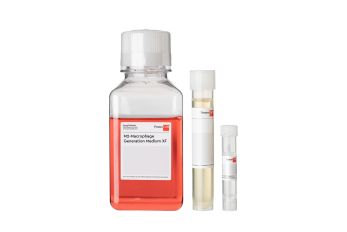One cell type can fight disease, help form blood vessels, regulate cell stability— and more. Macrophages are true masters of multitasking. In our body they are the first line of defense against invading bacteria, fungi and viruses. But they are not only a key element of our immune defense; they can also play a role in destroying tissue, and promoting diseases. This makes macrophages extremely interesting for research, and they show extraordinary potential for new therapeutic approaches.

Master of the weightless Macrophages:
Professor Ullrich from the University of Zurich teaches his cells to fly. With his group, he investigates impaired functions of immune cells in microgravity. The photo was taken at the 19th parabolic flight campaign by the DLR in 2013. Picture kindly provided by Professor Oliver Ullrich.
Various Types of Macrophages
Many different types of macrophages exist. These professional phagocytes are a heterogeneous population of functionally diverse cells with different origins. They can rapidly change their phenotype in response to variations in their environment. Researchers have tried to classify macrophages based either on their belonging to the mononuclear phagocytic system, their origin or their functional phenotype. According to the inflammation state, one can differentiate between M1- and M2-macrophages. Traditional classification tells us that IFNγ-activated M1 macrophages have inflammatory functions and are crucial for resistance to pathogens and their elimination. Alternatively, IL-4-activated M2 macrophages have mostly anti-inflammatory functions and are important for maintaining tissue integrity. However, in contrast to the good work they do when fighting diseases, M2-like macrophages are also found in several cancer types where they can promote tumor growth (Komohara, et al., Cancer Sci 2014).Research Applications of the “Big Eaters”
Macrophages are found in almost every organ. They protect the human body, but they are also involved in the pathogenesis of diseases, including autoimmune disorders, chronic inflammatory syndromes, fibrosis and cancer. Their research applications are vast, and in vitro assays are increasingly used in a wide range of research areas, including immunology, bacteriology and parasitology, as well as in biomedical and transplantation studies. Two advantages of macrophages in cell culture are that they are relatively easy to generate and to cultivate.
How to Generate Macrophages In Vitro
If you want to work with macrophages in vitro, you need a sufficient number and purity. But there is a problem: Although mature differentiated macrophages can be found in various human tissues, they are only present in very low numbers. Moreover, they cannot proliferate in vitro. The easiest way to obtain macrophages is to isolate peripheral blood cells and differentiate them with specific media. These monocyte-derived macrophages (MDM) are functionally equal to tissue macrophages. PromoCell’s M1- or M2-Macrophage Generation Media are defined and animal component-free complete media systems for the generation of MDM. They allow the differentiation of macrophages directly from PBMC without the need for additional bead-based purification of CD14+ monocytes, enabling the use of healthy, untouched cells without the interference of animal stimuli. Thanks to major advances in the understanding of macrophages’ biology, scientists are rapidly developing new therapeutic targets. Their efforts focus on enhancing or inhibiting macrophages’ responses to different stimuli, and the results of such experiments might help cure infectious diseases and autoimmune diseases – and even cancer. Such sky-high ambitions are certainly worth a session of weightlessness.Application Note “Differentiation of M1- or M2-Macrophages from PBMC/Monocytes“ (Free Download)
Learn within our latest application note how to differentiate monocytes or peripheral blood mononuclear cells into M1- or M2-macrophages.








